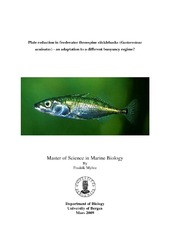Plate reduction in freshwater threespine sticklebacks (Gasterosteus aculeatus) - an adaptation to a different buoyancy regime?
Master thesis
Permanent lenke
http://hdl.handle.net/1956/7215Utgivelsesdato
2009-03-13Metadata
Vis full innførselSamlinger
Sammendrag
One of the striking differentiations freshwater threespine sticklebacks (Gasterosteus aculeatus) with a marine origin experiences, is a reduction in the numbers of lateral plates. This has been demonstrated to be caused by factors such as differences in predation pressure, the access of important ions that build these lateral plates or by pleiotropic effects, such as osmoregulation. However, another factor could be important for stickleback moving from marine to fresh water, a difference in buoyancy and this has to be compensated for. In theory compensation for this alternation in buoyancy could be done in three different ways, through hydrodynamic lift, a change in swim bladder volume or by modifying the tissue density. To obtain information on how freshwater threespine sticklebacks adapt to this difference in buoyancy, a comparison of a marine stickleback population and two different freshwater stickleback populations, one completely plated and on low plated, were performed. Buoyancy, tissue density, swim bladder volume and mass of lateral plates were registered. All three populations of stickleback showed buoyancy near to neutral to their natural environment (marine or fresh water). This indicates that freshwater sticklebacks use other strategies than hydrodynamic lift to compensate for the reduced buoyancy. Further, comparing the swim bladder volume of freshwater low plated sticklebacks with marine completely plated sticklebacks demonstrated that they are of equally size. The tissue density of the freshwater low plated sticklebacks was lower than in the completely plated sticklebacks. These findings may demonstrate that the main strategy for sticklebacks with a marine origin in freshwater, is to reduce the tissue density rather than increasing the swim bladder volume. Mass measurements of lateral plates, which explains most of the differences in tissue density between freshwater low plated and marine completely plated sticklebacks supports this even further.
